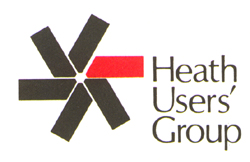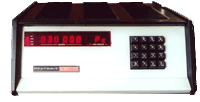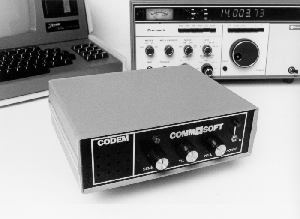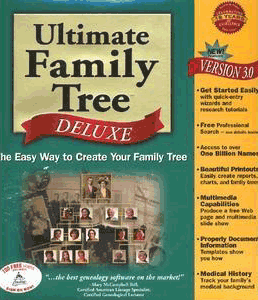
|
|
About COMMSOFT
|
|
| KN2MSP
In 1958 the amateur radio novice bands were shaken by the arrival of Howard Nurse. The FCC assigned KN2MSP on February 11, 1958, and Howard was soon on the air with a borrowed home brew 15 watt transmitter and a venerable National NC-109 receiver. A Heathkit DX40 replaced the home brew transmitter, and Howard passed the general exam in New York City that summer. Howard moved up to K2MSP, then received WB6HQF as a second call while in school in California. After graduation, he and his wife moved back to New Hampshire, where he was assigned W1DSB. |
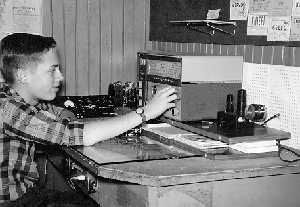
|
| W6LLO
By 1974, Howard and his family were living in Palo Alto, California. Howard was employed as an electrical engineer in the aerospace industry, but spent spare time building ham accessories and writing articles for Popular Electronics, RTTY Journal, and Ham Radio Magazine. Howard, by now W6LLO, was quite active on RTTY, as can be seen by the model 28 in the photo.
|
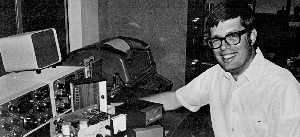
|
| Pre-COMMSOFT Days
The introduction of the Heathkit H8 computer in late 1977 provided the spark for what was to become COMMSOFT. The H8 served as a platform for early software development by Howard Nurse, then W6LLO. Howard's first software article appeared in the second issue of REMark Magazine, in October, 1978. REMark, published by Heath, was the "Official magazine for users of Heath computer equipment." Howard's article, "An ASCII/Baudot Driver for the H8 System," described an interface circuit and software for using a Teletype machine as a printer for the H8. Microsoft was two years old in 1977 and based in Albuquerque, New Mexico. |
|
|
|
|
|
The ASCII/Baudot driver was at the heart of Howard's first RTTY program, "W6LLO RTTY Communications Processor," announced in 1979 in REMark issue 6. The RTTY Communications Processor had been started in the Summer of 1978. At that time all program loading was done via a cassette tape deck. The H17 Disk Drive and HDOS (Heath Disk Operating System) were introduced in in late 1978. Each floppy disk stored a "massive" 102.4 kilobytes of data, and programs could be loaded in seconds rather than minutes with this new innovation. Howard soon converted the growing cassette-based RTTY program to disk and continued development. COMMSOFT Launched The RTTY Communications Processor, now up to version 3, was renamed RTTY89 and became COMMSOFT's first product in early 1980. Heath's H19 Video Terminal, announced in mid-1979, opened new possibilities for data display, which RTTY89 exploited. The program provided a 3-level split screen to allow the pretyping of messages while copying incoming data. "Complete system status" was also displayed by the program, plus automatic CW ID, disk I/O and ASCII or Baudot operation. RTTY89 required a system with 32K RAM. |
The W6LLO RTTY Communications Processor converts your H8/H17 system into an advanced radio teletype control center. When connected to a radio transmitter/receiver through a modem your computer will come alive with digital voices from around the world. This package performs the function of the communications operating procedures required by the FCC, or in common use through convention. Some of these duties include conversion of data back and forth from BAUDOT to ASCII; CW ID; timekeeping; text editing; data buffering; operating and system status indication; and remote control functions. Hardware requirements are an H8 with 24K, H17, H9 terminal, H8-2 with external UART, (schematic included) and an RTTY modem such as the RM-300 (as described in September 78 Ham Radio Magazine). Complete written documentation and users guide included with the diskette and full source code. Available now--order HUG P/N 885-1023 price--$22.00 + 10% postage and handling. Smaller type cassette version available in June. |
| COMMSOFT
Adds Ham Products
CW89 and Cipher89, both by Brent Simons, WA6CGX, were added to COMMSOFT's product line in 1981. CW89, with its split screen display, provided a pretype buffer for sending code and the display of incoming decoded Morse code. Cipher89 was a program designed for shortwave listening. It was able to decode Morse code and lightly encoded digital (RTTY) transmissions. For example, Cipher89 provided tools to flip bits in the incoming data stream to see if an otherwise unreadable message might appear. In the early days of ham computer applications there was no such thing as a TNC, or even a Soundblaster. To fill the need for a way to connect audio to the computer, Howard designed the Codem. The Codem was added to COMMSOFT's product line in 1981. COMMSOFT also became a dealer for the iRL line of RTTY Terminal Units.
|
|
| COMMSOFT
Introduces First Family Tree Software
ROOTS89, a genealogy program for the Heath Disk Operating System, was planned and started in 1980. ROOTS89 was one of the first commercially available genealogy programs, and thus caused quite a stir when first introduced at the West Coast Computer Faire in 1981. Herb Drake, N6QE, authored ROOTS89, along with a string of successor products. ROOTS/M quickly followed ROOTS89, being an adaptation of the same program for the CP/M operating system. This change greatly expanded COMMSOFT's market since CP/M was rapidly becoming a standard in personal computing. ROOTS II was COMMSOFT's first genealogy product designed for the IBM-PC. It was a major update to ROOTS89/M, adding many capabilities requested by customers.
|
|
| Slow
Scan Television for the Apple ][
PhotoCaster was the creation of Ken Rothmuller, WA6NFA, who saw the Apple II as an excellent basis for a Slow Scan Television (SSTV) system for amateur radio. Ken combined his passion for photography with his engineering skills in hardware and software design to create PhotoCaster. The PhotoCaster board had audio in and out jacks that could be connected directly to a ham transceiver to send and receive photos. The resolution of the images was fairly low due to limitations in the Apple video design. A second board, PhotoViewer, was added to the product line to improve the image quality by adding true gray scale and color pixels to the system. The PhotoViewer was the first gray scale video device for the Apple, and the resulting images were striking. COMMSOFT sold PhotoCaster, PhotoViewer, and a video camera with tripod in a complete image processing package to hams and others interested in this new grahics capability. |
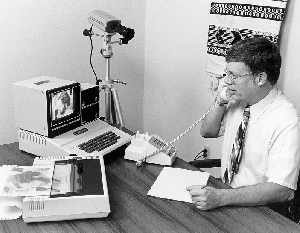 |
|
Genealogy Software for the Professional ROOTS III, announced in 1988, was the last genealogy program written by Herb Drake for COMMSOFT. ROOTS III was a major update for ROOTS II, and featured the ability to create printed reports using accepted genealogy formats, including source documentation. ROOTS was the first product to include these important capabilities, now considered standard for genealogy software. ROOTS III won many awards for its excellence in providing tools for the advanced genealogist. Howard Nurse designed and wrote ROOTS IV as a replacement for ROOTS III starting in 1991. ROOTS IV broke new ground in its approach to genealogical record keeping. It was based on an event model, which allowed for a great deal of flexibility in the content and type of data that could be stored. ROOTS IV allowed much more than the creation of family trees, treating family history and documentation as equally important genealogical goals. Visual ROOTS was COMMSOFT's first Windows genealogy program. It contained a subset of ROOTS IV's features and was designed to be sold through software distributors. COMMSOFT enhanced Visual ROOTS for Palladium Interactive, a new software company that saw the potential of the genealogy market. Palladium named this new product Family Gathering and began selling it in software stores. ROOTS V was the last genealogy product to be sold under the COMMSOFT name. Designed for the serious genealogist, it was the Windows version of ROOTS IV, with many enhancements. In 1997 COMMSOFT sold its product line to Palladium, and Palladium began marketing ROOTS V as Ultimate Family Tree. More details here.
|
|
| CommCat,
a return to ham radio roots
Howard Nurse, now W6HN, began the design and development of CommCat in 1999. With its release in early 2002, COMMSOFT's products have gone a complete circle. |
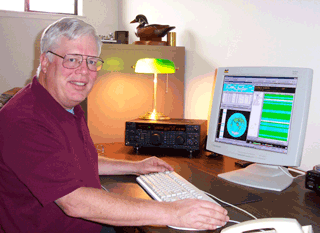 |
